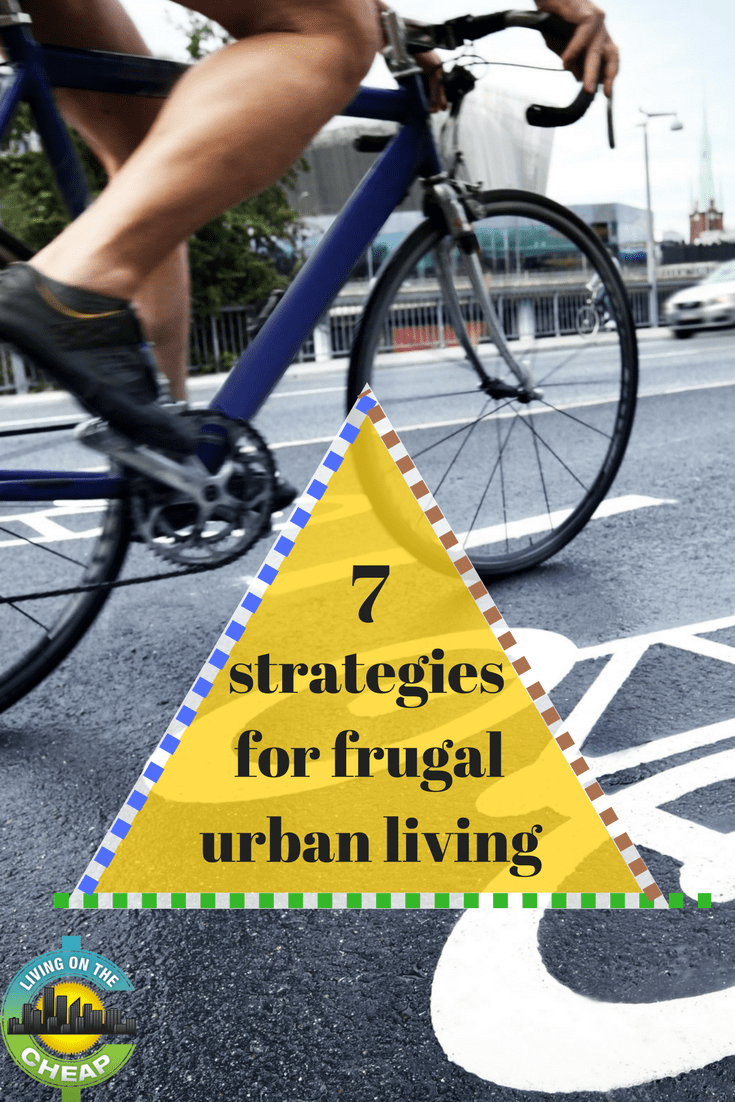The cost of living in a major metropolitan area runs higher than average. Frugal urban living is the ultimate oxymoron because there are just so many fun ways to spend money.

Consumer temptations abound in the city. From parking and lattes to fashion and entertainment, the cosmopolitan lifestyle can take a big bite out of your income, as well as rack up debt and leave you feeling empty and miserable.
We’re here to help with some simple strategies for frugal urban living that will tell you how to buy wisely and live happily.
What’s the difference between frugal and cheap?
In a word, being frugal is about understanding the difference between price and value.
Being cheap considers only the amount spent in dollars and cents.
Value can certainly be measured in terms of cost. But many other factors can contribute to the value of any purchase.
Strategies for frugal urban living
Know the different between value and price
Here’s a comparison of two pairs of shoes at very different prices that helps to explain the principle of value:
One pair of shoes cost $40. They are constructed of man-made materials glued together and wear out after one year. The shoes cannot be repaired and must be discarded.
The other pair of shoes cost three times as much at $120. They are constructed of leather materials sewn together. After two years, the soles show some wear and the leather looks almost new. The soles can be replaced for around $25 to provide another two years wear. With regular repair, these shoes can last at least 10 years, perhaps longer.
Which shoe is the better value? The first pair costing $40 provided one year of use. The second pair cost $120 and provided two years of use before requiring $25 for new soles, to be repeated every two years. After 10 years, these shoes cost a total of $120 + (5 x $25) = $245 or $24.50 per year (less if the shoes last longer than 10 years).
Although the second shoes cost three times more than the first ones, the second pair is a better value if repaired for 10 years. This is a straightforward example of value that can be calculated in dollars and cents. However, other factors that may affect value are not so cut and dried.
What if you need new shoes now and only have $40? What if the $40 shoes are trendy and you simply prefer fashion over anything else? What if you walk a lot…or very little? What if the inexpensive shoes do not fit well and you develop foot, posture, or joint problems requiring medical attention? What if you had another shoe choice costing $240; would this pair be a better value than the ones costing $120? What is the return policy on any of the shoes if you are dissatisfied? What if you are allergic to leather? Or you are vegan?
As you can see, value is not always about calculating cost or savings. Many factors can contribute to your perception of the value of any purchase and whether you decide to buy it.
Find half-price tickets to entertainment, sports and events in your city
Know your three N’s: Necessities, nest egg, non-essentials
Necessities include housing (mortgage or rent and utilities), food, clothing, transportation, and medical or health expenses. These living expenses should require no more than 50% of your take home pay.
Your nest egg has a few parts. First, you need enough cash (in an interest-bearing savings account) to cover a minimum of three months living expenses, plus a reserve for any expected annual expenses such as insurance premiums or taxes. Beyond that, put nest-egg money (30% of your take home pay) into a retirement account.
What’s leftover — 20% of your take home pay — can go towards non-essentials. These extras include smartphones, entertainment, dining out, home services, personal services, vacations, and any other extras beyond your necessities.
If you are over-budget in either necessities or non-essentials, you are living an extravagant lifestyle above your means. That is, you are slowly going broke and definitely not living frugal.
And the five R’s: Reduce, repair, reuse, recycle, rent
Before you buy anything on your shopping list, especially clothes and household goods, evaluate whether you need to buy something new.
Do you really need it? Some people refuse to add a new item to the household unless they discard something else. Can you repair or re-purpose something you already own? Can you rent it?
If you must by it, can you trade or barter for it, or buy it used or second-hand?
Spend with purpose — curate, don’t buy on impulse
Spend purposely by only shopping from a list. This goes for groceries, clothes, household goods, non-essentials, or any other purchase.
If you’re tempted to buy something not on your list, resist the impulse and simply postpone the purchase by adding it to a future shopping trip. After you give yourself time to think about it more carefully, you may decide against it.
For example, I considered purchasing a new chair for the living room. It was to die for. After considering other options, I decided to re-purpose an unused chair from another part of the house, recovered it, and saved hundreds of dollars. I felt very clever, relieved, and happy.
Never pay full price
There are many ways to save money: Clipping coupons, downloading smartphone apps, signing up for loyalty programs, keeping track of seasonal shopping bargains, using coupon books, perusing deal websites, and buying discount gift cards.
“The Ultimate Guide to Coupons” explains how to use these techniques to save money on everyday items from shampoo to auto maintenance, as well as niceties like dining out and going to the movies. It’s written by veteran frugalists right here at Living on the Cheap. The book is available in print or via download:
Amazon sells the print version for $12.95. Buy “Ultimate Coupons” here.
Or save $4.95 and buy the downloadable book for just $10. Download “Ultimate Coupons” here.
Put people over things
American marketers are adept at tempting us with happiness and success through the purchase of things. If you haven’t already figured it out, I’m happy to be the one to tell you: It’s a lie.
Relationships with people are worth more than any of the things that money can buy. These include casual conversations with a barista or bus driver, your work relationships, your faithfulness as a friend, and commitment to family (whether they’re blood relatives or adopted into your life for any reason).
So along with understanding the difference between price and value, understand that people and relationships are the stuff that money can’t buy. They simply have no price.
Focus on needs, not wants.
Going back to the three N’s, focus most of your time and attention on necessities and building a nest-egg. Be purposeful in the value you place on things, and get creative about your purchases.
Do you need an expensive smartphone with a big data plan — or could you do more of the tasks from your computer by adjusting your daily habits? Do you need to eat out several nights a week — or could you eat in more nights with a little pre-planning to cook dinner with friends or family? Have you tried “shopping your closet” and simply combining items differently to make new outfits?
Parting thoughts on frugal urban living
So these are some basic strategies to achieve a frugal urban lifestyle. It’s not a matter of buying cheap. It’s not austerity or self-denial. Quite the opposite.
Frugal urban living is a matter of spending wisely. It’s about thoughtful economy, appropriating the value of things and people, and building a contented and happy life.
If you liked this article, you may also enjoy:
How frugal are you? 25 things frugal people do
Save money, get fit, organize your life and have more fun this year




I appreciate the sentiment of the article, but the high cost of housing paired with wage stagnation particularly in urban areas makes much of this advice irrelevant. In Denver you’re lucky to find a one-bedroom apartment for under $1500/mo. If you’re making enough to have your necessities cost less than 50% of your income, you probably aren’t reading LotC.
Yes, I hear this response often to ideas such as these. Yes, living costs are rising and wages aren’t. You can wait it out and hope that some future raise digs you out or some miracle happens, like you win the lottery. Or, you can take some control and try some or any one of the suggestions. I live in one of the most expensive cities in the country, much higher than Denver. And I’m near retirement age. So you won’t get any sympathy from me.
A few years ago, I adopted the “$4/day” grocery spending plan. Now it sometimes creeps up to $6-7, but it’s a far cry from the $10-12–and more–I used to spend. Plus I really like what I eat compared to when I was spending more money. I recently read an blog post from a guy who only had $36 to spend each month on groceries…so that’s what he spent. And he worked very hard to eat healthy–Google eating on $30 a day and read the article by Andrew Hyde. I watched another video where the author gave about 10 ideas for making extra money every month, even $100 a month can make a huge difference. Google “side gigs” and see what you come up with. I plan to write an article on side gigs soon, as I find the time.
Last year, in addition to my fulltime job, I started driving for Uber Eats to pay off my credit card. The credit card debt was due to some household emergencies last year–for which I didn’t have enough money set aside. So after the credit card is paid off, I will build that emergency allowance up. It will take me most of this year to build an adequate emergency allowance. The nice thing about Uber is, you can work when you can–a few hours or a lot of hours, here or there, wherever you can fit it in. Uber Eats is better for me than driving people, because my car is old (and paid for) and doesn’t meet Uber requirements for people.
Note that the thing about credit cards is, you should only use them for emergencies and planned expenses that you already have the money set aside for. Many people use credit cards for essentials or to otherwise fund a lifestyle above their means–bad, bad, bad idea.
This year, I’m working to change my living arrangement to reduce costs–I’m exploring several options from getting roommates to downsizing and even some radical ideas (such as teaching English in a foreign country for two years). So, there is no “sentiment” in this article. They are things I or others have done to turn things around.
If you think “this can’t work”, it tends to be self-fulfilling. It will never work because you’ve already given up before you’ve tried. If you try one thing and it doesn’t work, you try another. And so on. And on. And on.
The advice “live below your means” is timeless and applies to anyone, anywhere. Any financial planner or consultant will tell you this works because it does. Because this is arithmetic, not abstract thinking. If your expenses are higher than your income, you are getting poorer everyday. And the only way to fix it is to reverse it. And the only way to reverse it is to change your circumstances. And the only way to change your circumstances is to try and try again until you do. If you need more concrete ideas, let me suggest this article: https://livingonthecheap.com/get-rich-slowly-by-living-below-your-means/.